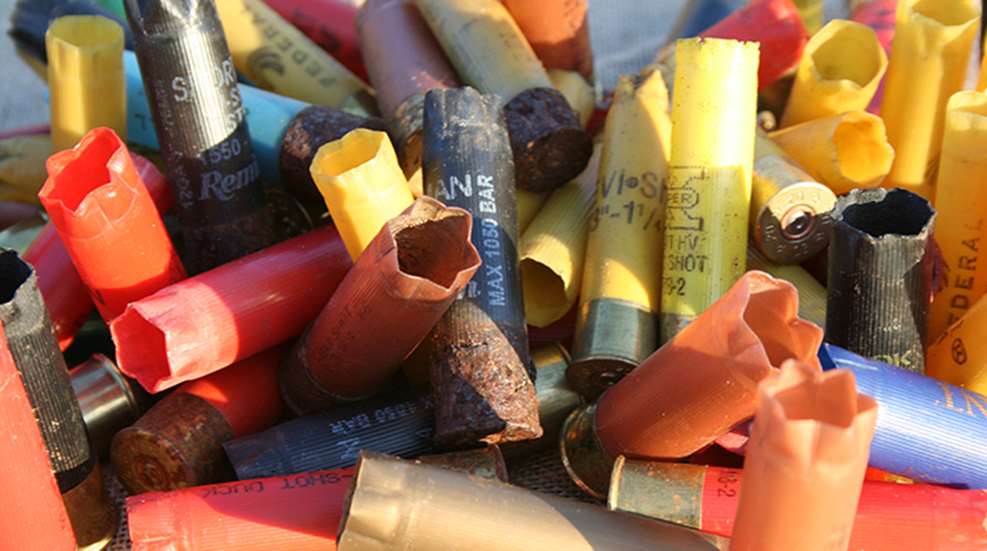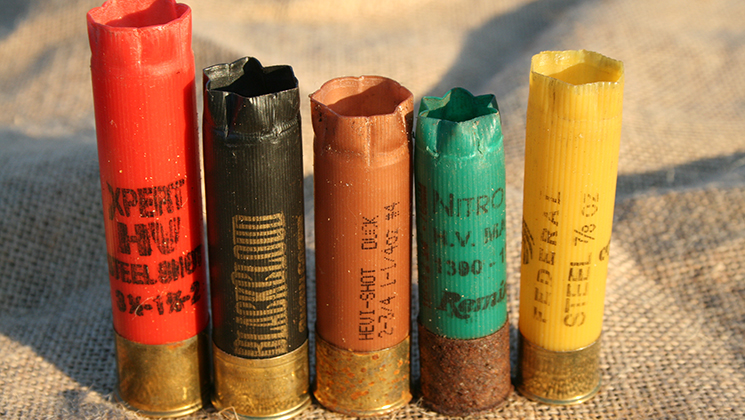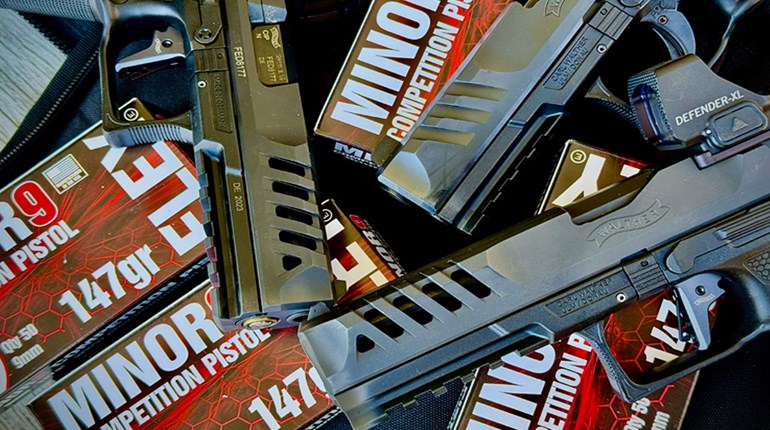
If you’re a dedicated waterfowler like me, much forethought goes into the gear that’ll accompany you afield on a given day. Depending on the future weather conditions, hunting locale and anticipated species and shooting style/distances, my decoys (if used), calls, firearm and shotshells can vary greatly—there’s no single selection that’s ideal for all situations. It’s for this reason that, despite my two decades’ worth of waterfowling experience, I’m always actively seeking to improve upon my repertoire of knowledge and equipment. And, as I found, at times invaluable knowledge can be gleaned from the unlikeliest of sources—in this case, trash.
Call it an epiphany; upon entering the Chincoteague, Va., waterfowl blind of Eastern Shore outfitter Capt. Andy Linton, a couple of spent shotshell hulls scattered about the floor immediately caught both my attention and thoughts. “What were those hunters using?” I pondered. Inspecting the weathered remains revealed the answers and, at the same time, commenced a two-year odyssey to collect hulls and analyze the trends.
This methodology is highly subjective; the hulls gathered depended upon a myriad of circumstances that caused them to remain in the blind and/or flora surrounding it. As such, I complemented trends noted from hull collection with those found in Internet forums and ammunition manufacturers’ sales reports. The results of my efforts are discussed below. Does your waterfowl loads compare favorably, or are they an anomaly? Read on.
Chamber Champ
It was anticlimactic “discovering” that I collected more 12-gauge, 3-inch hulls than all others combined—including 12-gauge. 2¾- and 3½-inch; 16-gauge 2¾-inch (one); and 20-gauge, 3-inch—because said chambering is ubiquitous among American shooters. Nearly all newly manufactured 12-gauge shotguns are chambered to accept 3-inch shells, and 3½-inch-chambered guns can utilize them, too. As with turkey-specific shotshells, technological advancements in propellant and wad design, as well as the metallurgy of shot, have resulted in hard-hitting, far-reaching 3-inch waterfowl loads that leave little to be desired—thus negating the need for 3½-inch shells except for a few specific circumstances. What was surprising, though, was that that 20-gauge, 3-inch hulls outnumbered those in 12-gauge, 3½-inch. Obviously, the 20-gauge is growing in popularity among duck hunters. This sentiment is echoed on the web, too. According to Rick Stoeckel, brand manager civil ammunition for Federal Premium Ammunition, “Three inch is much bigger [in sales] than all the others. [Twenty gauge] is second to 12 but dwarfed by the 12.”
Cost Conscious ... or Not?
Given the liberal limits—notwithstanding licensed swan hunts and more regulated species, such as the American black duck—waterfowling isn’t typically a one-and-done affair. Dispensable income and volume, as well as, availability, shooting skill and shot distance, often guide ammunition-purchasing decisions. Within the realm of waterfowl loads there exist three general categories: economical (steel); middle ground (“premium” steel or blends); and top-notch, which features higher-density shot (HEVI-Shot, Bismuth, Tungsten-Matrix, HEAVYWEIGHT, etc.). Whereas economical steel loads pack plenty of punch to ground waterfowl within reasonable ranges, plated and/or shaped steel (i.e. DryLok, Blind Side, Black Cloud), blends, and high-density shot types can induce more trauma and, in the case of the latter, greatly increase the effective range.
Given the plethora of speedy divers buzzing the blinds on the Eastern Shore, I wasn’t too surprised that the majority of hulls were from value-priced loads. Of the brands, though, Winchester’s Xpert High Velocity was disproportionately represented in both 12-gauge, 3- and 3½-inch. In 20-gauge, 3-inch Federal’s Speed-Shok was most popular. In inexpensive waterfowl loads, the web is abuzz with love-hate relationships with specific brands but, in general, price trumps everything else; whatever is on sale gets the nod. As for the middle-ground loads, HEVI-Metal (steel/HEVI-Shot blend) took top honors, outnumbering all other “premium” steel loads combined. On forums the love-hate relationship peaks within the “middle-ground” category; some shout “supreme” while others decry “gimmick.” This is in contrast with Stoeckel’s observations, reporting that “[premium steel loads] are very popular. They are sold and used in every market for shooters who want a step up in performance.” The company sells a lot of Black Cloud.
Few people will argue about the effectiveness of high-density shot; however, the per-shell price is difficult for many waterfowlers to swallow. That being said, in the blinds that I hunted there was no shortage of hulls from HEVI-Shot (Duck) and Kent (Bismuth and Tungsten-Matrix) alongside their cheaper counterparts. Most were HEVI-Shot.
Select Your Size
Want to be privy to heated exchanges? Read online forums about shot size preference. Navigating the debates reveals that most waterfowlers opt for No. 2 steel for ducks (and sometimes decoying geese) and BB for geese, while a surprisingly sizable (and growing) segment chooses No. 4 steel—especially for decoying ducks. Some hunters elect to split the difference and vouch for No. 3 steel. As Federal Cartridge Company’s J.J. Reich explained, “We push 3s for ducks (good in-between load) and 2s for smaller geese (early season and snow geese). Then BBs for larger Canadas and late season.” Stoeckel suggested No. 2, 3, and 4 shot for ducks, and No. 2, BB, and BBB for geese. Keep in mind too that most brick-and-mortar stores carrying waterfowl loads—nearly always economical options—stock BB, No. 2, and No. 4 shot sizes. For high-density shot types, No. 4 is most popular for ducks. At the end of the day, however, shot size is primarily determined by the size of the bird(s) pursued, the anticipated shot distances, and gauge used. For example, as it’s restrained by bore diameter, seldom are shot sizes larger than No. 2 employed in the 16 and 20 gauge.
Hull collection echoed my online findings and Stoeckel’s report. Number two proved to be the most popular; however, there were nearly as many hulls with “No. 4” stamped on their sides as “No. 2.” Given the proliferation of divers (especially the smallish buffleheads), that makes sense. I also recovered some spent shells that sent No. 6, No. 3, and BB steel downrange, but they were significantly less in number. As for high-density shot, hulls previously loaded with No. 6 (HEVI-Shot) shot outnumbered those that utilized No. 4s.
Picking a Payload
Hunters utilizing steel loads are (or should be) keenly aware of the fact that, due to steel’s low density, pellets must be propelled to high velocities to be terminally effective. The latest trend, though, is to propel steel pellets in excess of 1600 fps. (if not 1700 fps). The tradeoff for increased speed is often reduced payload. For many hunters, the increased per-pellet energy (and thus range) earned from higher velocities outweighs the decreased pattern density, while others wholeheartedly disagree. Finding a consensus online proved impossible; concerning 12-gauge, 3-inch alone, there were a seemingly equal number of proponents for 1 1/8-, 1¼-, and 1 3/8-oz. steel loads. According to Reich, “In some markets, especially down south or during early seasons [lightweight, high-velocity loads outsell slower, heavier ones]. But in northern areas and late season, with more plumage, the heavier payloads are better.”
As with the previous category, specialty payloads (like shot sizes) aren’t as available in “big, box” stores and thus aren’t used as much. This was especially apparent when milling through the trash hulls; 12-gauge, 3-inch, 1 3/8-oz. loads were only represented by Winchester Blind Side (mostly in No. 2). One-and-an-eighth and 1¼-oz. loads were similar in number. But, when considering the payloads of 12-gauge, 3½-inch loads, lightweight trumped heavyweight; all but one steel load had 1 3/8 ounces of No. 2 or 3 shot. In high-density shotshells, the trend was to go heavy; 1 3/8 ozs. was most common in HEVI-Shot (Duck) and 1½ ozs. in Kent (Bismuth).
How did my shotshell selection “track” with the aforementioned trends? While hunting the Eastern Shore over decoys on several occasions with Capt. Linton, my 12-gauge, 3-inch shotgun my was loaded with one of the following loads: Winchester DryLok Super Steel 3-inch, 1¼-oz. No. 3; Browning BXR 3-inch 1¼-oz. No. 2; Federal Black Cloud Close Range 3-inch, 1¼-oz. No. 3; Kent Fasteel 3-inch, 1¼-oz. BB; or one of myriad handloads utilizing ITX Extreme 13 (No. 6) or No. 2 or BB HEVI-Shot ranging from 1 oz. to 1 3/8 ozs. Accompanying me was my son using a 20 gauge loaded with: Federal Black Cloud 3-inch, 1-oz. No. 2; Winchester Blind Side 3-inch, 1 1/16-oz. No. 5; HEVI-Shot Duck 3-inch, 1¼-oz. No. 4; or handloads featuring 1 oz. of No. 3 or 4 steel. The aforementioned combinations accounted for mixed bags featuring one or more of the following species: Atlantic brant, black duck, bufflehead, bluebill, hooded merganser, and gadwall. Of course, this all changes when I’m pass shooting Canada geese.
It’s often said, “you learn something new everyday if you pay attention.” Those hunters’ trash taught me a lot.
So what’s your chosen load?






































